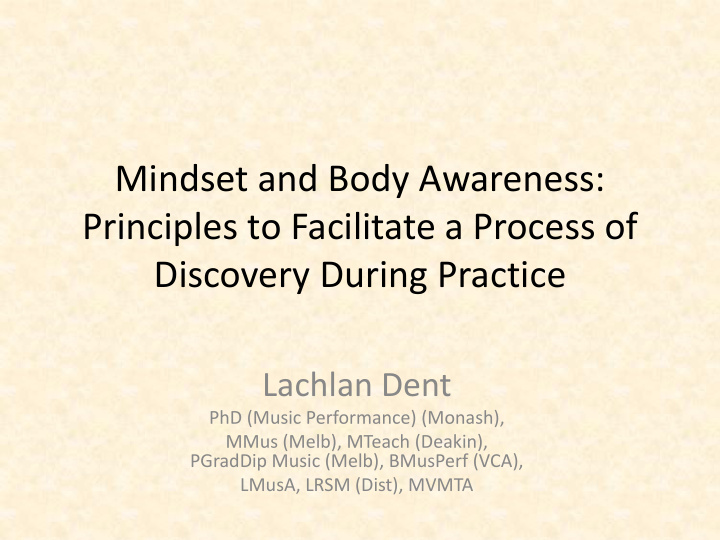



Mindset and Body Awareness: Principles to Facilitate a Process of Discovery During Practice Lachlan Dent PhD (Music Performance) (Monash), MMus (Melb), MTeach (Deakin), PGradDip Music (Melb), BMusPerf (VCA), LMusA, LRSM (Dist), MVMTA
Poll time! • Which instrument do you play/teach? • Reminder to Lachlan: Stop sharing screen or risk a Zoom disaster!
Areas to Cover • Finding Your Own Way • Understanding the Instrument • Facilitating the Instrument’s Needs (Body Use/Breathing) • Practice Processes and Brain Function • Releasing Tension Caused by Expressiveness in Playing
Finding Your Own Way • “Everything the last teacher said was wrong” • Starting with what happens to the instrument, then secondarily finding ways of moving to facilitate the instrument’s requirements • Non-negotiables • Defining Variables • Movement as Gestalt • It’s your body
Towards an Investigative Approach • Data collection (we need all of the data!) • Need for technical predictability • A curious and problem-solving mindset (assume that there is a solution!)
Ariadne’s Thread and Occam’s Razor (and not manipulating results!)
…not manipulating results! • Fear and the Amygdala • Desensitisation and acceptance facilitate more reliable feedback • Letting go of ambition • Removing visual stimuli/distractions (e.g. sheet music) • Feedback pathways: Touch (connection to instrument), Proprioception, Sound. • Feeling the resistance of the string
Proprioception • Proprioception refers to the body's ability to perceive its own position in space • If one has a faulty concept of where a joint exists in the body, the body will operate according to that faulty concept • It’s worth investing in a model skeleton to see how things work from the inside out!
Bow Variables • Proximity to Bridge (Placement) • Bow Speed • Weight/Pressure • Angle of Bow • Three basic results: Crunchy, Airy, Beautiful (Helmholtz)
Placement vs Pressure/Weight
Properties of the String • Let’s look at what actually happens to the string when it vibrates Slow-motion Bowed String • Properties of the string and how they relate to bowing • How notes start (grab-release process)
Placement • Needs to change depending on string length (proportional relationship) • Can be affected by bow angle • Doesn’t really affect volume in itself (but allows greater bow pressure closer to the bridge) • For the same bow weight and speed, the bow will need to be closer to the bridge for higher strings than for lower strings
Variables to do with the Left Hand • Please join me on August 11 at 7:30pm for another webinar! • The Left Hand for Cellists: Form, Function and Intonation
Complete Tension Release • True masters usually display effortlessness • We can actually start with this appearance of effortlessness (and then find the ‘result’ within that approach) • We don’t want to slump/collapse
Eliminating Tension: It’s Easy! • (if you breathe, and don’t worry about how it sounds!) • Tension release facilitates body awareness (but body awareness still needs to be a priority) • How it might sound after tension release: “Shreds” videos
Some Ideas for Putting Everything Back Together • Hierarchy of Elements: • Body Use • Rhythm (Pulsing Process) • Tone • Pitch
Pablo Casals on Co-ordination “Only this impulse, coming from the center of the body instead of each extremity, will group the different movements in a unified whole, producing better results and less fatigue. This impulse…is rather like an image of what I feel at the time, not an easy thing to identify or to name”
Breathing • Diaphragmatic breathing • Noticing your breath away from the instrument • 1-2 breathing (i.e. making exhalations twice as long as inhalations)
Meditation Techniques • Breath Awareness • Mantra-based meditation • Mindfulness • Wim Hof Method • (There are many others!)
Changing Habits and Learning • Myelin Sheath • The man without a Hippocampus • Zone of Proximal….Frustration!
Learning from Children’s Learning Very little children tend to: • Focus on what takes their interest • Repeat and refine a single element of a task • Move on once they are bored
Practice Techniques • Counting out loud (with long sounds) • If you make a mistake…DON’T stop! • Looping/refining sections • Correct errors – but practice getting it right! • Dropping the bow onto the string • Starts of notes only • String Analysis (isolating the bowing)
String Analysis
Specific Case: Expression Causing Tension • High-end speakers/headphones can be almost indistinguishable from a live musician… • Yet the equipment experiences no emotion and the emotion of the performance is preserved • Discovering expressive meaning of different types of sound in the practice room… • And staying as cool as a cucumber when actually making those sounds in performance!
Things to Investigate • High-end audio gear. Headphones give the best sound quality vs money spent, but research first! • https://plus.maths.org/content/why-violin-so-hard- play • Bulletproof Musician • Wim Hof Method • Humanual by Betsy Polatin • Alexander Technique • Body Mapping • Feldenkrais • Deliberate Practice
Q & A Time! • Genevieve Newton will now join us to moderate the Q & A
Recommend
More recommend